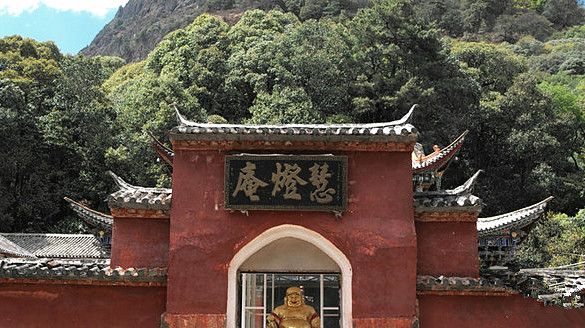HuidengAn Temple of Cangshan Mountain in Dali City
Huiteng Nunnery (慧灯庵) is located at the foot of the eastern slope of Tianzhu Peak (天柱峰) — also known as Chaping Peak (插屏峰) — with the Jiaye Hall (迦叶殿) behind it and the main path leading up to the summit passing in front. According to historical records, in 1605 (the yisi year of the Wanli reign in the Ming Dynasty), a monk named Hong Ping (洪平) built a thatched hut here and lived in seclusion. In 1634 (the jiaxu year of the Chongzhen reign), his disciple Puxian (普现) raised funds to expand the site into Huiteng Nunnery. Later, in 1692 (the renshen year of the Kangxi reign in the Qing Dynasty), Monk Zong Hai (宗海) again raised donations to renovate it.
- Chinese Name: 慧灯庵
- Location: At the foot of the eastern slope of Tianzhu Peak (天柱峰) or Chaping Peak (插屏峰)
- Backed by: Jiaye Hall (迦叶殿)
- In front: The main pilgrimage path to the summit of Tianzhu Peak (天柱峰)
Historical Anecdotes
Since ancient times, Huiteng Nunnery (慧灯庵) has been a must-pass monastery on the main path to the summit of Tianzhu Peak (天柱峰). In the first lunar month of 1639, the great traveler Xu Xiake (徐霞客) visited Jizu Mountain (鸡足山) and mentioned “Huideng Temple (会灯寺)” and “Huideng Avenue (会灯大道)” in his Travel Diaries in Yunnan (滇游日记). He referred to the Huideng Avenue leading to the summit of Tianzhu Peak (天柱峰) as the “Main Path.” At that time, Huiteng Temple was a place for pilgrims to burn incense, rest, and enjoy tea before ascending to the Golden Summit. Reportedly, the vegetarian meals of Huiteng Nunnery were once quite renowned.
Scenic Features
After the founding of the People’s Republic of China, the government allocated funds for repairs in 1952 and again in 1963. Unfortunately, the site was destroyed during the “Cultural Revolution.” The current Huiteng Nunnery was rebuilt in 1983 on the original site with government funding. The new complex includes the Mahavira Hall, abbot’s quarters, and side rooms, totaling 933 square meters.
The Mahavira Hall is built with reinforced concrete in a five-bay, double-eaved, hip-and-gable style. Inside the hall stands a statue of Shakyamuni in the center, with Kasyapa (迦叶) to the right and Ananda (阿难) to the left. In the side niches, Bodhidharma (达摩祖师) is on the left and Guan Yu (关帝), the Dharma protector deity known as the Garan Guardian (伽蓝神), is on the right.
According to Buddhist lore, Guan Yu (关云长), the general of the Shu kingdom during the Three Kingdoms period, manifested at Yiquan Mountain (玉泉山) after his death, received monastic precepts from the Tiantai Master Zhizhe (智者) and sought Chan wisdom from Master Shenxiu (神秀). He was later venerated as a Garan Guardian in Buddhist tradition.
Surrounded by ancient trees and dense forest, Huiteng Nunnery resonates with birdsong every morning and evening year-round — just as the old poetic line says, “With birds singing, the mountain feels even more serene.” Behind the nunnery stands an ancient camellia tree known as the “Nine Hearts and Eighteen Petals,” more than 240 years old. It produces ten-petal blossoms resembling a lion’s head, typically blooming around the Chinese New Year.
From the front of Huiteng Nunnery, visitors can look up and admire the majestic presence of the Lengyan Pagoda (楞严塔) of Jinding Temple (金顶寺), soaring into the clouds atop Tianzhu Peak (天柱峰).

 7 Days GolfingTour
7 Days GolfingTour
 8 Days Group Tour
8 Days Group Tour
 8 Days Yunnan Tour
8 Days Yunnan Tour
 7 Days Shangri La Hiking
7 Days Shangri La Hiking
 11 Days Yunnan Tour
11 Days Yunnan Tour
 6 Days Yuanyang Terraces
6 Days Yuanyang Terraces
 11 Days Yunnan Tour
11 Days Yunnan Tour
 8 Days South Yunnan
8 Days South Yunnan
 7 Days Tea Tour
7 Days Tea Tour
 8 Days Muslim Tour
8 Days Muslim Tour
 12 Days Self-Driving
12 Days Self-Driving
 4 Days Haba Climbing
4 Days Haba Climbing
 Tiger Leaping Gorge
Tiger Leaping Gorge
 Stone Forest
Stone Forest
 Yunnan-Tibet
Yunnan-Tibet
 Hani Rice Terraces
Hani Rice Terraces
 Kunming
Kunming
 Lijiang
Lijiang
 Shangri-la
Shangri-la
 Dali
Dali
 XishuangBanna
XishuangBanna
 Honghe
Honghe
 Kunming
Kunming
 Lijiang
Lijiang
 Shangri-la
Shangri-la
 Yuanyang Rice Terraces
Yuanyang Rice Terraces
 Nujiang
Nujiang
 XishuangBanna
XishuangBanna
 Spring City Golf
Spring City Golf
 Snow Mountain Golf
Snow Mountain Golf
 Stone Mountain Golf
Stone Mountain Golf














